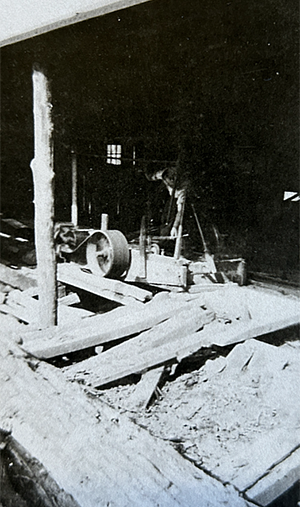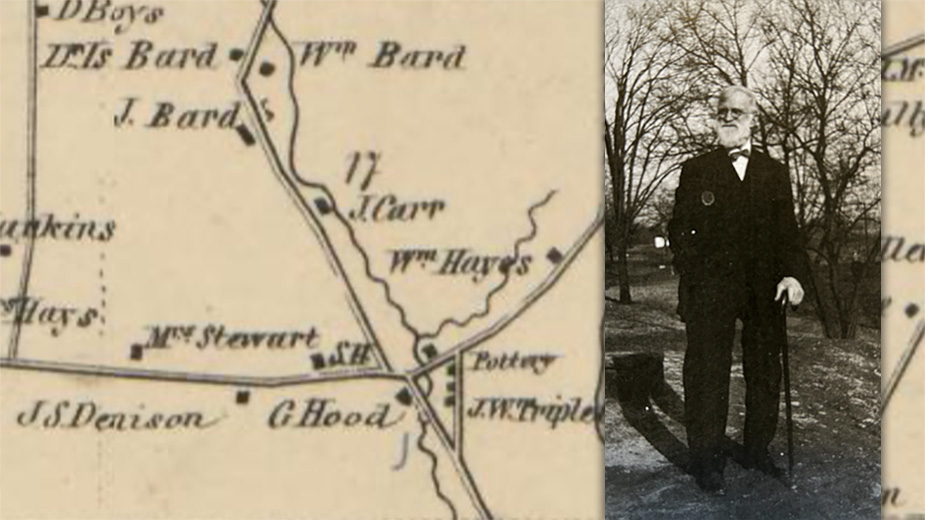LIBERTY TOWNSHIP – Allan Banner, a lifelong resident of Liberty Township, peers down a small ravine choked with weeds and overgrown brush on land his family still owns after more than two centuries. The site was home to his ancestor’s first business venture, a sawmill that supplied timber to the active coal mining operations approximately a half-mile south in a village that was then unofficially called Mineral City.
“My family – the Bards – settled here in 1817,” Banner says as he surveyed the old site. “Parts of my family were here from early on.” A map of Trumbull County, published in 1856, shows members of the Bard family spread out along acreage south of the Vienna Township line and north of the village. The map also depicts several coal banks, a pottery, a schoolhouse and a nearby tavern.
Missing on that map, however, is the name of the town, which by that year had been rechristened “Sodom.”
A ‘PERFECT SODOM’
From a 21st century perspective, it’s an unusual name for this neighborhood in Trumbull County, today replete with magnificent houses and leafy wooded streets in an area encircling the intersection of Tibbetts-Wick and Sodom-Hutchings roads. Those who arrive at the crossroads expecting an enclave of debauchery, vice, and excess worthy of “Sodom and Gomorrah” will be greatly disappointed.

Not so in the mid-19th century. This section of Liberty Township had emerged as a center for coal mining, especially the veins tapped at Sodom. The camps during the 19th century were filled with toughened workers who toiled in the nearby slope mines, many of them immigrants from Wales, Ireland, and Germany.
“My family started the sawmill for the coal mines and eventually the steel mills,” Banner says. During the 19th century, the mining community was known for its raucous workforce, he says, noting that miners found entertainment in the village’s several taverns and other social centers. “There were five bars and three houses of ill-repute,” he says, noting the hamlet would draw from other nearby operations.
“I would assume this was the same in other coal mining areas,” Banner says.
For others though, the mining village offered fertile ground for social reform as the temperance movement took hold across Trumbull County. By 1830, annual alcohol consumption among adults in the United States reached an average of 7.1 gallons per year. Moreover, health nostrums were often concoctions laced with alcohol, while farmers found that distilling excess corn into whiskey provided additional revenue.
Indeed, an item published in 1885 in the Mahoning Dispatch championed the use of alcohol to combat illness, citing a Dr. Shorrt of Madras: “Bring the patient under the influence of intoxication as speedily as possible; make him drunk and keep him drunk until the virus is overcome.”
Religious and social reformers – many of them women – posited that the source of violence, poverty, illness, depravity and criminal behavior lay at the bottom of a bottle.
Although the origins of how the crossroads were dubbed Sodom lack definitive evidence, the name is generally traced to an incident during the early 1840s when an itinerant preacher arrived at Mineral City to denounce the evils of alcohol. According to the History of Trumbull and Mahoning Counties by H.Z. Williams, published in 1882, a social activist by the name of Dr. Fisher had presented a lecture on temperance at Church Hill in Liberty. Those attending persuaded the speaker to talk on the subject at Mineral City at the local schoolhouse and encourage church attendance.
Few in the community were interested, Banner says. “Nobody showed,” he says with a laugh. “I guess they appreciated the houses of ill-repute [more] than the house of God.”
Instead, when Fisher returned to Church Hill to deliver another speech advocating temperance, he “jocosely remarked that he had not been successful in his effort at the schoolhouse and he feared that the locality was a perfect Sodom,” according to Williams.
“The miners liked the name,” Banner says, and afterward the hamlet was known as Sodom, earning a post office status from 1874 to 1903. An 1899 map of the area lists in bold type the Sodom P.O.
Mining in the area took off following the Civil War – the most prominent Sodom mine was in an area directly behind a Mormon Church at the intersection of Tibbetts-Wick and Sodom-Hutchings. It 1877, that mine closed for good but work in the area continued.
Meanwhile, social reformers continued their crusade against alcohol abuse, evidenced by local groups such as the Trumbull County Women’s Christian Temperance Union and The Vienna Temperance Society, along with other prominent organizations such as the Anti-Saloon League, founded later in Oberlin, Ohio, in 1893.
It’s coincidence that Wayne Wheeler, the leading advocate for the 18th Amendment, Prohibition, was born in Brookfield in Trumbull County.
Although the temperance movement did bring enough political pressure to curb overall alcohol consumption and eventually prohibition in 1920, it was clear that hard-bitten miners and others in the community still drank heavily, as evidenced by a tragic incident reported by the Mahoning Dispatch in the late 1870s.
“Two coal miners, Charles and Wm. Bailey, employed in the mines at Sodom, were killed on the A. & G. W. railroad at Warren last Monday night,” reads a story dated Sept. 12, 1879. “They had been drinking considerable during the day, and it is supposed they sat down on the track and went to sleep. Their bodies were horribly mangled and bruised.”
At times, others in Sodom found themselves on the other end of the law for alcohol-related infractions. “Lib Paine, of Sodom, Trumbull Co., confessed that she sold liquor to minors,” says an item dated Nov. 13, 1885, in the Dispatch. “Besides a fine of $25 and costs she got five days in the county jail.”
FAMILY BUSINESS THRIVED

Banner says Sodom was among the earliest settlements in Liberty Township, along with Girard and Church Hill. “Before the railroads, Sodom, Seceder’s Corners – present day Churchill Road and Logan Way – and Church Hill were bigger cities than Girard,” he adds. Girard would soon surpass the three in population because of a decision to locate railroad hubs there as the iron industry expanded.
Still, the family’s sawmill thrived, Banner says. During the mid-1800s, the Bard sawmill was able to secure a steam engine from a sunken riverboat that the company purchased. “They brought it up and started the first steam-powered sawmill in Ohio,” he says, supplying timber for the nearby mining industry.
“My great-great-great-granddad delivered the timber from a team of horses and a wagon,” he says. The mill expanded its customer base as the steel industry rose in prominence across the Mahoning Valley. His great-grandfather, John Linus Bard, operated the sawmill during the 19th and early 20th centuries.
Today, few traces of the village remain. A structure built in 1921 that houses an upstairs tattoo business and an office for a construction company still stands at the intersection. Some of the houses nearby have foundations dating to the mid 19th century.
Banner, now retired, still lives on land once owned by the Bard family, as do other relatives in this portion of the township. They keep alive a family presence that dates to the early days of White settlement here.
Pictured at top: Map of Sodom, 1856, showing Bard land. Inset: John Linus Bard, 1925.
